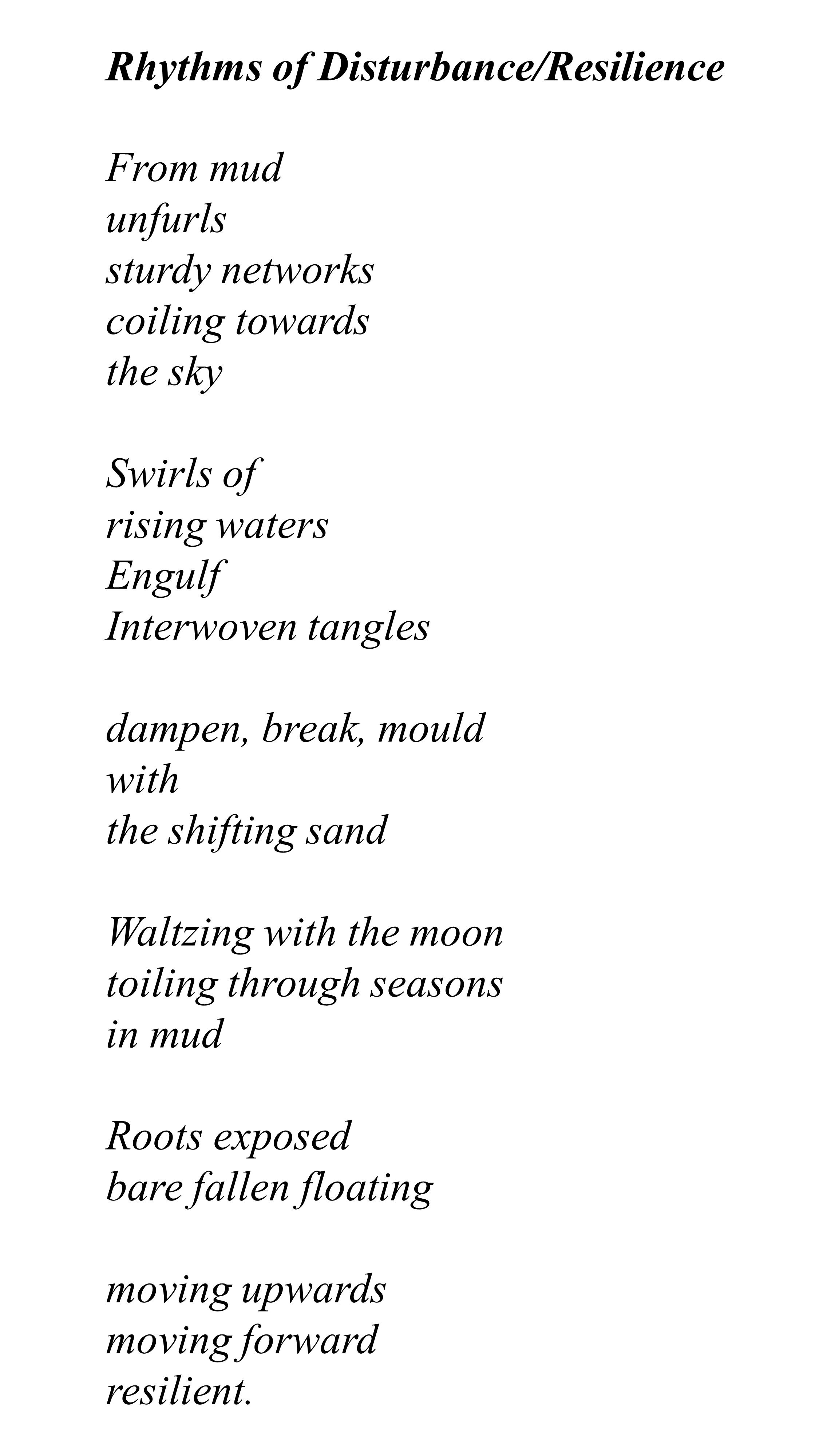Rhythms of Disturbance/Resilience
Dina Rasquinha & Kathryn Koopman
Artwork part of ‘Diversity’ Issue 6
The Science
This collaborative poetry and music art piece translates the tangled networks and multiple interactions that dominate mangrove ecosystems of the east coast of India. In ecology, disturbance and resilience are often seen as two sides of the same coin. Ecosystems that experience moderate levels of disturbance are predicted to harbor more biodiversity and expected to be more resilient. Moreover, this piece highlights the intersectionality of human agency especially of marginalized communities—the diversity of voices in mangrove conservation that are underrepresented or go unnoticed, the diversity of mangrove species—each with different levels of resilience, recovery time and the stressors that make/break ecosystems. The forest struggles to maintain harmony, reflected through the increasing (musical) note intensities that resemble the myriad disturbances that these trees encounter. Similarly, women who have direct interactions with these forests are entangled in cultural and socioeconomic norms which don’t generally conform to ideas of conservation, but essentially live it through the choices they make each day. The region is characterised by a diversity of cultures—Odia, Bengali, and refugees from Bangladesh. Added layers of religion, caste and gender further influence agency in decision making, land ownership and rights, as well as the level of state influence in changing the landscape. The rhythms of everyday life, intersect, with unequal positions of power across space and time, often transgressing the fuzzy boundaries of gender, religion, caste and culture, just like the fuzziness between land-mangrove-water.
The music highlights the rhythms of intersectionality between mangrove-human-non-human worlds through the interaction of a rich selection of musical instruments weaved in with the poetry. The tabla represents different types of disturbances the trees encounter, both human induced and ecological, and the "mangrove" motive responds to these different disturbances in different ways: sometimes it is hesitant and takes a while to lock back into a groove, while other times it is very confident in its resilience. The percussion plays environmental sounds to echo the space of the estuary, sometimes working in tandem and sometimes against the disturbances.
The Artist
Dina Rasquinha is a scientist and a poet. She is currently pursuing her doctoral studies in the Department of Geography & Integrative Conservation Program at the University of Georgia. Her research focuses on blue carbon discourses related to mangrove ecosystems in the Indian subcontinent. She is interested in how social and philosophical constructions of space, culture and gender intersect with spatial ecology and policy. To read more about her work, visit drasquinha.weebly.com or her Instagram page @_mudboots_ or follow her on Twitter at @drasquinha
Kathryn Koopman is a performer, music educator, and electro-acoustic composer from Dallas, Georgia. As a composer, Kathryn’s music is often inspired by the natural world and by cross-collaborations in the disciplines of art and dance. She has written for many mediums, including wind band, choir, chamber ensembles, and electronics. Her works have been performed by Dal Niente Ensemble, Southland Ensemble, Transient Canvas, Bent Frequency Duo, Pie for Two, Safety Second, Rote Hund Muzik, and D@wgbyt3s Electronic Ensemble. Learn more about her work from her website https://kathrynkoopman.com/
The following musicians were also involved in the creation of this work: James Matthew Terrell (Guitar), Daniel Karcher (Viola), Alexis Rose Boylan (Violin), Freeman Leverett (Tabla), and Andrew Blair (Percussion).
Copyright statement. This work is published under the CC BY-NC-SA license

